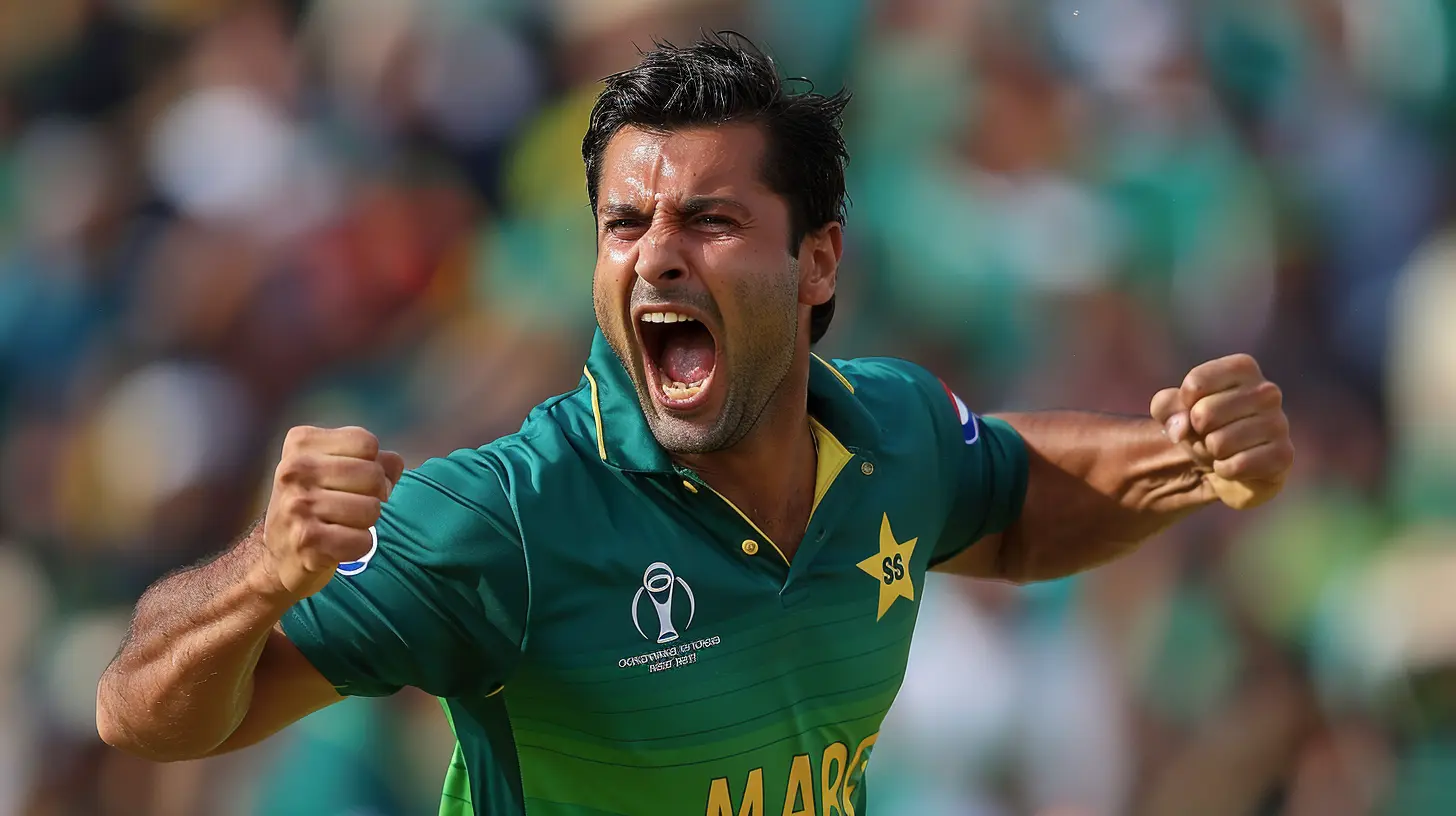How Spin Bowlers Are Revolutionizing Modern Cricket
22 December 2024
Cricket, a sport steeped in tradition, has undergone significant evolution over the years. While the pace bowlers once dominated the game's narrative with their raw speed and aggression, spin bowlers have slowly but surely carved out a niche for themselves. Today, spin bowling is no longer just a tactical tool used to break partnerships. Instead, it has become an art form that is reshaping how cricket is played at all levels—from Test matches to T20 leagues.
But how exactly are spin bowlers revolutionizing modern cricket? This article will dive deep into the factors that have led to the rise of spinners, how they've adapted to the ever-changing dynamics of the game, and why they are now more essential than ever.

The Rise of Spin Bowling in Modern Cricket
Spin bowling has always been a part of cricket, but its prominence, especially in the shorter formats of the game, has skyrocketed over the last few decades. Gone are the days when spinners were brought into the attack merely to give the fast bowlers a breather. Now, they're often the ones who initiate the attack, creating pressure, and taking crucial wickets.A Shift in Strategy
One of the primary reasons for the rise of spin bowling is the shift in cricket strategies. With the advent of shorter formats like T20, and even One Day Internationals (ODIs) becoming more fast-paced, teams have had to rethink how they approach the game. In these formats, where every run matters and the margin for error is razor-thin, spinners have proven to be invaluable.Why? Because they're unpredictable. A good spin bowler can make the ball dance in ways that fast bowlers simply can't. With variations like the googly, doosra, and carrom ball, spinners can bamboozle even the most experienced batsmen. And in a game where one wrong move can lead to a wicket, that unpredictability is gold.
The Impact of T20 Cricket
T20 cricket, in particular, has been instrumental in the rise of spin bowlers. In a format where batsmen are constantly looking to smash the ball out of the park, spinners have become the perfect counter. They slow down the pace of the game, making it harder for batsmen to time their shots. And when you're facing a bowler who can turn the ball both ways, it becomes a game of cat and mouse.Spinners like Sunil Narine, Rashid Khan, and Imran Tahir have become household names in T20 leagues around the world, thanks to their ability to contain runs and pick up wickets. In fact, it's not uncommon to see teams employing two or even three spinners in a T20 game, a strategy that would have been unthinkable just a decade ago.

The Evolution of Spin Bowling Techniques
Spin bowling isn't just about turning the ball anymore. Modern spinners have added a plethora of variations to their arsenal, making them more dangerous than ever.The Art of Flight and Deception
One of the most significant innovations in modern spin bowling is the use of flight and deception. Bowlers like Ravichandran Ashwin and Nathan Lyon have mastered the art of tossing the ball up, inviting the batsman to go for a big shot, only to deceive them with the dip and turn. It's a delicate balance—bowl too short, and you get hammered; bowl too full, and you're driven. But bowl it just right, and you have the batsman second-guessing every shot.In a sense, spin bowling is like a game of chess. You're constantly trying to outthink your opponent, setting traps, and luring them into making mistakes. And in modern cricket, where the mental side of the game is just as important as the physical, this kind of tactical approach has proven to be highly effective.
The Importance of Variations
In the past, spinners primarily relied on one type of delivery—either the off-spin or the leg-spin. But modern spinners are much more versatile. They can bowl a variety of deliveries, each with subtle differences in spin, speed, and trajectory. The googly, for instance, is a leg-spinner’s best friend—a delivery that spins the other way, catching the batsman off guard.Then there's the doosra, a delivery that spins in the opposite direction to an off-spinner's usual stock delivery. It's tricky to bowl and even trickier to play. Saqlain Mushtaq, Muttiah Muralitharan, and Harbhajan Singh have all used this delivery to tremendous effect, leaving many top-order batsmen scratching their heads.
More recently, we've seen the rise of the carrom ball, a delivery flicked off the bowler's fingers that can spin either way. Ravichandran Ashwin and Ajantha Mendis have popularized this variation, adding yet another weapon to the modern spinner's arsenal.
The Role of Wrist Spinners
Wrist spinners, in particular, have seen a resurgence in modern cricket. Unlike finger spinners, who primarily rely on subtle changes in grip and finger pressure, wrist spinners use their wrists to impart a greater degree of spin on the ball. This makes them harder to predict, especially on pitches that offer even the slightest assistance.Bowlers like Rashid Khan, Kuldeep Yadav, and Adam Zampa have taken the art of wrist spin to new heights. Their ability to generate sharp turn, even on flat pitches, has made them a nightmare for batsmen in all formats of the game.

Adapting to Different Formats
One of the reasons spinners have been so successful in modern cricket is their adaptability. Unlike fast bowlers, who often have to adjust their lengths and speeds significantly between formats, spinners can largely stick to their strengths, making only minor tweaks depending on the format.Test Cricket
In Test cricket, where patience is key, spinners are used to build pressure over long spells. They're not necessarily looking to take wickets with every ball but rather to create doubt in the batsman's mind. A good Test spinner will bowl a consistent line and length, forcing the batsman to play defensively and eventually make a mistake.Spinners like Rangana Herath and Nathan Lyon have been masters of this approach, grinding batsmen down over the course of a session and picking up crucial wickets when the pressure finally gets too much.
One-Day Internationals
In ODIs, spinners are often used in the middle overs to contain the batsmen and break partnerships. The key here is variation—mixing up the pace, flight, and angle to keep the batsman guessing. Bowlers like Shakib Al Hasan and Yuzvendra Chahal have been highly effective in this role, using their variations to tie down batsmen and pick up wickets.T20 Cricket
In T20 cricket, spin bowlers have become the go-to option for containing runs. With the field restrictions in place and batsmen looking to score quickly, spinners can slow the game down and force mistakes. The key in T20 is to be unpredictable—whether it’s a slower ball, a quicker one, or a delivery with extra flight, the batsman should never know what's coming next.Rashid Khan, for instance, has become one of the most feared bowlers in T20 cricket, thanks to his ability to bowl a variety of deliveries with pinpoint accuracy. His combination of leg-spin, googlies, and faster deliveries has made him nearly unplayable, even for the best T20 batsmen in the world.

Spin Bowling and Technology
Another factor contributing to the rise of spin bowling in modern cricket is the use of technology. With tools like video analysis, ball-tracking systems, and biomechanical feedback, spinners can now fine-tune their techniques like never before.Video Analysis
Video analysis has been a game-changer for spinners. By studying footage of opposition batsmen, bowlers can identify weaknesses and tailor their strategies accordingly. For instance, if a batsman struggles against deliveries that turn away from them, a spinner can focus on bowling more leg-spinners or googlies.Biomechanics
Biomechanics has also played a role in the evolution of spin bowling. With the help of technology, coaches can analyze a spinner's action in minute detail, ensuring that they're generating maximum spin and accuracy without putting undue strain on their bodies. This has not only improved the effectiveness of spinners but also helped them avoid injuries.The Future of Spin Bowling
As cricket continues to evolve, there's no doubt that spin bowlers will play an increasingly important role. With the rise of franchise leagues around the world, where pitches are often slow and conducive to spin, bowlers who can turn the ball will be in high demand.Moreover, as teams continue to search for new ways to gain an advantage, we may see even more innovation in the world of spin bowling. Whether it's new variations, improved techniques, or better use of technology, one thing is for sure—spin bowlers are here to stay, and they're only going to get better.
Conclusion
In a sport that is constantly evolving, spin bowlers have managed to stay relevant by adapting their techniques, strategies, and approaches to fit the modern game. Whether it's through their ability to deceive batsmen with flight and variations or their knack for containing runs in the shortest formats, spinners have proven time and again that they're an indispensable part of any cricket team.As the game continues to evolve, it's clear that spin bowlers will play an increasingly important role in shaping the future of cricket. So, the next time you watch a cricket match, keep an eye on the spinners—they might just be the ones pulling the strings behind the scenes.
all images in this post were generated using AI tools
Category:
CricketAuthor:

Preston Wilkins
Discussion
rate this article
19 comments
Kestrel Smith
Spin bowlers are redefining the dynamics of modern cricket by introducing unpredictability and strategic depth to the game. Their ability to manipulate the ball's trajectory and deceive batsmen is proving invaluable, leading to innovative tactics and revitalizing interest in spin bowling, once overshadowed by pace.
March 24, 2025 at 12:28 PM

Preston Wilkins
Thank you for your insightful comment! I completely agree—spin bowlers are indeed bringing a fresh dynamism to the game, highlighting their crucial role in evolving cricket strategies and engaging fans.
Camille McLaughlin
In the dance of dust and mystery, spin bowlers weave magic, reshaping the game. With every turn and drift, they craft new legends upon the pitch.
February 19, 2025 at 9:13 PM

Preston Wilkins
Thank you! Spin bowlers truly add an enchanting dimension to the game, transforming matches and creating memorable moments.
Ezra McConkey
Who knew that turning a ball could be more revolutionary than a politician's campaign? Spin bowlers are spinning their way into cricket history—now if only they could spin the runs back to the batsmen!
February 5, 2025 at 3:16 AM

Preston Wilkins
Thanks for the insightful comment! Spin bowlers truly are changing the game, and their impact on the pitch is definitely more compelling than political theatrics!
Mason Reed
Spin bowlers elevate cricket's strategy.
January 29, 2025 at 3:35 AM

Preston Wilkins
Absolutely! Spin bowlers add a unique tactical dimension to the game, challenging batsmen to adapt their techniques and strategies, ultimately enhancing the overall complexity of cricket.
Mika O'Neal
Spin bowlers are the wizards of the cricket world! Their creativity and skill bring excitement to the game. Embrace the magic and let the spin revolution continue! 🏏✨
January 24, 2025 at 9:11 PM

Preston Wilkins
Thank you! Spin bowlers truly add a unique flair and strategic depth to the game—it's exciting to see their impact grow! 🏏✨
Shiloh Kelly
Great article! It’s fascinating to see how spin bowlers are changing the game with their clever tactics and precision. Their ability to outsmart batsmen adds an exciting layer to modern cricket. Can’t wait to see how this evolution unfolds in upcoming matches!
January 19, 2025 at 8:15 PM

Preston Wilkins
Thank you! I'm glad you enjoyed the article. The evolution of spin bowling is certainly thrilling, and it will be exciting to see how it continues to shape the game!
Jasmine Summers
What a fantastic read! It's exciting to see how spin bowlers are reshaping the game of cricket. Their unique techniques and strategies are not just captivating but are also bringing a fresh dynamic to the sport. Looking forward to seeing how this evolution unfolds in upcoming matches!
January 16, 2025 at 1:25 PM

Preston Wilkins
Thank you! I'm glad you enjoyed the article. It's certainly exciting to witness the evolving impact of spin bowlers on the game!
Riven Duffy
Great article! It’s fascinating to see how spin bowlers are reshaping the game. Their unique techniques and strategies indeed add an exciting dynamic to modern cricket. Looking forward to more insights!
January 12, 2025 at 8:44 PM

Preston Wilkins
Thank you! I'm glad you found it fascinating. Spin bowlers truly are transforming the game, and I'm excited to share more insights soon!
Xavi Torres
Great article! It's fascinating to see how spin bowlers are reshaping strategies in modern cricket. Their unique skill sets truly enhance the game's dynamics. Looking forward to more insights!
January 3, 2025 at 7:54 PM

Preston Wilkins
Thank you for your kind words! I'm glad you found the article insightful. Stay tuned for more!
Tilly Fisher
Ah yes, because who needs fast bowlers when spin is clearly the most thrilling way to put fans to sleep, right?
December 28, 2024 at 10:02 PM

Preston Wilkins
Spin bowlers bring a unique strategy and finesse to the game, adding depth and excitement that can be just as thrilling as fast bowling.
Callie Mathews
The rise of spin bowlers in modern cricket marks a significant tactical evolution. Utilizing variations in speed, angle, and spin, they exploit batsmen's vulnerabilities, enhancing match dynamics. This shift not only challenges traditional batting strategies but also emphasizes the importance of adaptability in today's game.
December 26, 2024 at 5:47 AM

Preston Wilkins
Absolutely! The evolution of spin bowlers is reshaping cricket tactics, forcing batsmen to adapt and innovate. Their unique skills are crucial in transforming match dynamics.
Falkor McAleer
Spin bowlers are the real game-changers—who knew turning the ball could outsmart even the fastest pacers? Love it!
December 25, 2024 at 12:49 PM

Preston Wilkins
Thank you! Spin bowlers indeed bring a unique strategy and finesse to the game, proving that skillful finesse can often outwit raw pace. Glad you enjoyed the article!
Francesca Reilly
This article astutely captures the resurgence of spin bowlers in modern cricket, highlighting their tactical adaptability and game-changing impact. However, it could delve deeper into the psychological challenges faced by batsmen against spin, as understanding this dynamic is crucial for appreciating the full scope of the spin revolution.
December 25, 2024 at 4:00 AM

Preston Wilkins
Thank you for your insightful comment! I appreciate your suggestion to explore the psychological challenges batsmen face against spin, and I'll consider expanding on that in future discussions.
Candice Parker
This article beautifully highlights the incredible impact of spin bowlers on the game. Their unique skills and innovation truly transform cricket, creating excitement and challenging batsmen in new ways.
December 24, 2024 at 7:59 PM

Preston Wilkins
Thank you! I'm glad you enjoyed the article and appreciate the vital role spin bowlers play in shaping the game. Their artistry truly adds a dynamic element to cricket!
Blade Hensley
Spin bowlers are like the magicians of cricket, pulling off jaw-dropping tricks that leave batsmen baffled! With their sneaky deliveries and crafty variations, they’re not just spinning the ball but also turning the game on its head. Who knew a little twirl could spark such big excitement? Go team spin!
December 24, 2024 at 3:33 AM

Preston Wilkins
Absolutely! Spin bowlers truly add a magical dimension to the game, showcasing skill and strategy that can completely change the outcome. Their artistry is essential in modern cricket!
Genevieve McPhee
This article beautifully highlights the transformative impact of spin bowlers in contemporary cricket. Their strategic play not only challenges traditional batting techniques but also enhances the game's excitement. It’s fascinating to see how these talented athletes are redefining the dynamics on the field. Thank you for sharing such insightful perspectives!
December 23, 2024 at 11:34 AM

Preston Wilkins
Thank you for your thoughtful comment! I’m glad you found the article insightful and appreciate your recognition of spin bowlers' impact on the game.
Joanna Castillo
This article compellingly highlights the resurgence of spin bowling in modern cricket, emphasizing its strategic evolution. However, it could further explore the balance between traditional techniques and innovative tactics, offering deeper insights into how spinners adapt to diverse playing conditions.
December 23, 2024 at 3:35 AM

Preston Wilkins
Thank you for your insightful feedback! I appreciate your suggestion to delve deeper into the balance between traditional techniques and innovative strategies in spin bowling. I’ll certainly consider this for future discussions.
Noelle Underwood
Spin bowlers are redefining cricket’s dynamics, blending artistry and strategy. Their ability to deceive batsmen showcases the game's evolving complexity and excitement.
December 22, 2024 at 8:59 PM

Preston Wilkins
Thank you! Spin bowlers are indeed transforming the game, captivating fans with their skillful deception and strategic depth. Their artistry adds a thrilling dimension to modern cricket.
Meredith Ramirez
Spin bowlers: transforming the game with creativity and skill!
December 22, 2024 at 1:32 PM

Preston Wilkins
Thank you! Spin bowlers indeed bring a unique blend of creativity and skill that adds depth and excitement to the game.
MORE POSTS

How to Structure the Perfect Full-Body Workout

The Role of Analytics in Modern Sports Leagues

The Rise of Unconventional Shots: From Switch-Hits to Scoops

The Importance of Footwork in MMA: Learning From the Best
The Power of a Handshake: Iconic Sportsmanship Gestures in Sports

Dehydration and Heat Exhaustion: Recognizing and Avoiding the Risks

Athletes Who Redefined Sportsmanship with Grace and Integrity

Why Communication Can Make or Break Your Team’s Performance

Choosing the Right Running Shoes for Maximum Performance

Top Grappling Techniques Every MMA Fan Should Know

Sportsmanship Awards: A Testament to Character in a World of Competition

The Impact of New Rules on College Sports: Preparing for the Pros